Young people in the NDSHS
In Australia, young people (those between the ages 10 and 24) are identified as one of the priority groups in the National Drug Strategy 2017–2026, as they are more vulnerable to behaviours associated with alcohol, tobacco and other drug related issues which can lead to adverse health and social outcomes (Department of Health and Aged Care, 2017).
The National Drug Strategy Household Survey collects data from people aged 14 and over from all states and territories. In this article, estimates related to alcohol, tobacco, and other illicit drug use among young people will be drawn from people aged 14–17 and people aged 18–24.
Fewer young people consumed alcohol monthly
In 2019, young people aged 18–24 were most likely to drink alcohol monthly, but not as often as weekly. In 2022–2023, the proportion who drank alcohol monthly decreased from 34% to 29% (Figure 1), meaning that young people were most likely to drink alcohol weekly, but not as often as daily, for the first time since 2010.
The long-term increases in the proportion of young people who did not drink any alcohol or did so infrequently continued in 2022–2023: 1 in 5 (20%) drank alcohol less often than monthly (up from 13.6% in 2001) and 16.3% had never had a full glass of alcohol (up from 7.5% in 2001).
The proportion of daily drinkers and ex-drinkers among people aged 18–24 has remained stable since 2001 and did not change between 2019 and 2022–2023 (Figure 1).
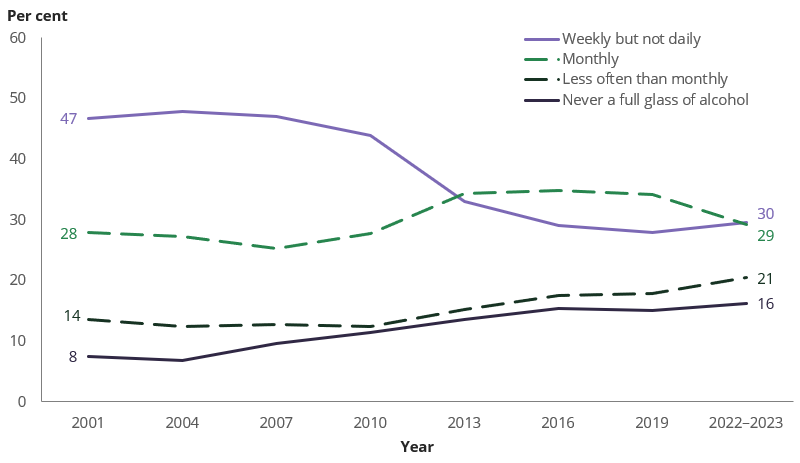
Note: ‘Daily’ and ‘Ex-drinker’ have been excluded. Numbers were below 5% in all years.
Source: NDSHS 2022–2023, Table 4.6a.
Which alcoholic drinks did young people prefer?
People who reported having consumed alcohol in the previous 12 months were asked which type of alcohol they consumed most often. Across all young people surveyed, the most commonly chosen beverage was pre-mixed spirits in cans and bottles (for example, Vodka Cruisers or Bourbon and Cola). However, preferences varied by both age and gender (Figure 2):
- Among people aged 14–17 who recently consumed alcohol, pre-mixed spirits were the main drink of choice. This preference was higher among females (64%) than males (35%). Bottled spirits such as scotch, rum and Kahlua were the next most common (*22% for males and *14.7% for females).
- For females aged 18–24, pre-mixed spirits were also the most common choice for an alcoholic drink (48%), followed by bottled spirits and liqueurs (26%).
- Choices were different among males aged 18–24, who were most likely to consume regular strength beer (36%) followed by pre-mixed spirits (24%).
* Estimate has a relative standard error between 25% and 50% and should be interpreted with caution.
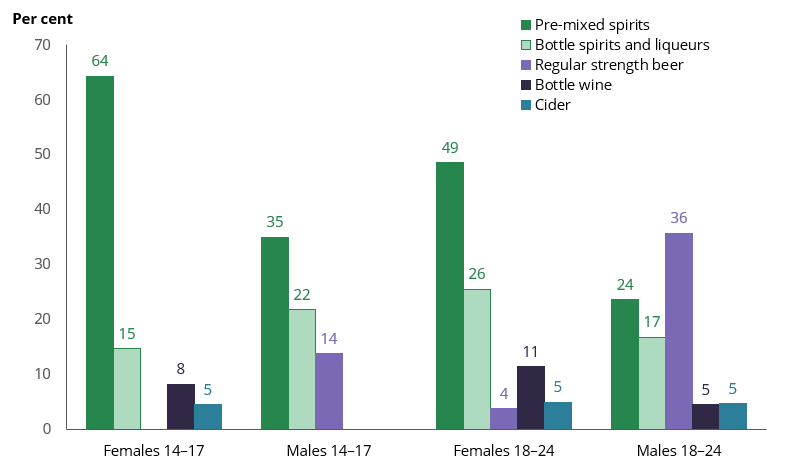
Source: NDSHS 2022–2023, Table 4.8.
Young risky drinkers more likely to be female than in 2019
The Australian Guidelines to reduce health risks from drinking alcohol state that people aged 18 and over should drink no more than 10 standard drinks per week on average and no more than 4 standard drinks in a single day. People aged under 18 should not consume alcohol (NHMRC 2020).
Risky alcohol consumption in all years has been evaluated according to the guidelines released in 2020. See Measuring risky drinking according to the Australian alcohol guidelines (AIHW 2021) for more information.
For most population groups, the proportion drinking alcohol at risky levels remained stable between 2019 and 2022–2023, even though the updated recommendations on how much alcohol a person can consume without putting their health at risk were released between the two survey waves in 2020. This means that behaviour has not changed substantially following the release of these recommendations.
This was also true for young people aged 18–24, with around 4 in 10 (42%) consuming alcohol at risky levels in both 2019 and 2022–2023. However, this hides the differences between young males and young females (Figure 3). In 2019, males aged 18–24 were much more likely to consume alcohol at risky levels (47%) than females of the same age (35%). In 2022–2023, this gap narrowed considerably, with 45% of males drinking at risky levels compared to 40% of females.
This relative increase in risky drinking behaviour among young females also occurred in the use of electronic cigarettes/vapes and illicit drugs, showing an overall trend in increasing risky behaviours among young females.
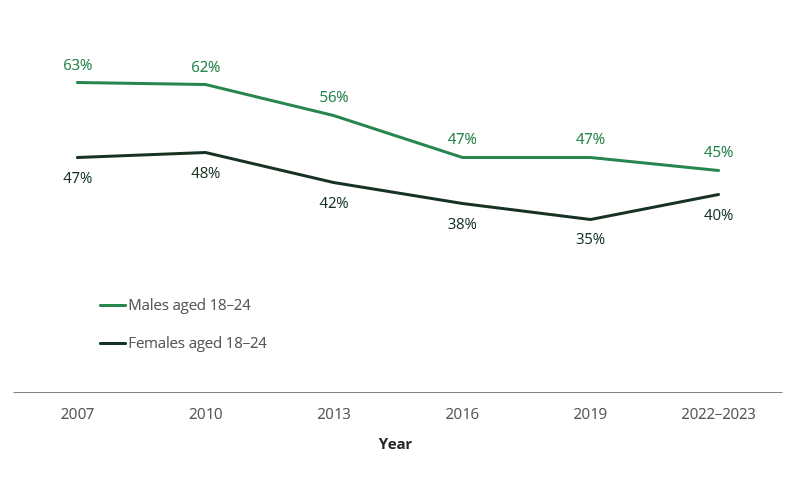
Note: Data from 2007 to 2019 have been re-analysed according to the Australian guidelines to reduce health risks from drinking alcohol (NHMRC 2020).
Source: NDSHS 2022–2023, Table 4.28.
It is recommended that people under the age of 18 do not consume alcohol: any level of alcohol consumption can put their health at risk. In 2022–2023, 31% of young people aged 14–17 had consumed alcohol in the previous 12 months, a similar proportion to 2019 when 30% had done so but a substantial reduction since 2001 when 69% of young people had recently had an alcoholic drink.
Once again there was a difference between young males and young females (Figure 4). While only 28% of females aged 14–17 had consumed any alcohol in the previous 12 months in 2019, 35% had done so in 2022–2023. In contrast, the proportion of males aged 14–17 who had done so reduced from 32% to 27% in 2022–2023.
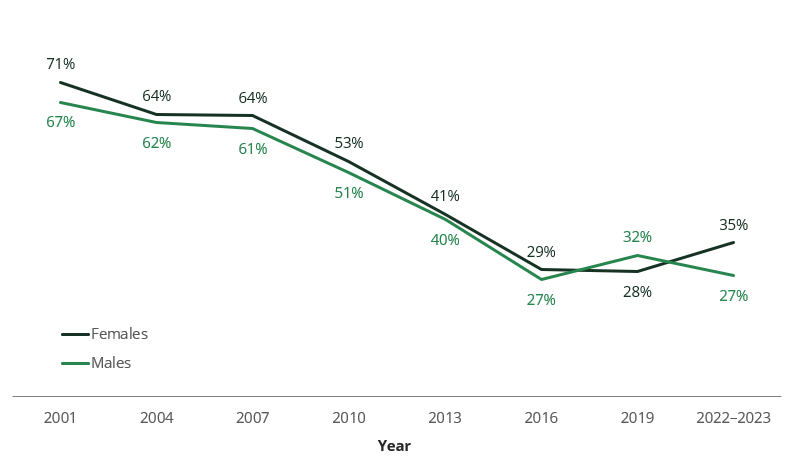
Source: NDSHS 2022–2023, Table 4.6.
The proportion of people under the age of 18 who had consumed any alcohol in the previous 12 months does align with general beliefs about young people’s alcohol consumption in Australia:
- Almost 1 in 3 people (32%) believe that a 16- or 17-year-old can occasionally drink 1 or 2 standard drinks without putting their health at risk.
- Around 1 in 4 people (24%) believe that it is beneficial to provide a 16- or 17-year-old with a little bit of alcohol in preparation for drinking as an adult.
What do young people think about consumption of alcohol under the age of 18?
Alcohol consumption before the age of 18
In general, young people were much more likely to agree that a 16- or 17-year-old could occasionally drink 1 or 2 standard drinks without putting their health at risk and that it is beneficial to introduce a 16- or 17-year-old to a small amount of alcohol as a preparation for adulthood. Those aged 14 to 17 were much more likely to agree with both statements, although people aged 18–24 were still more likely to agree than the general population (Figure 5).
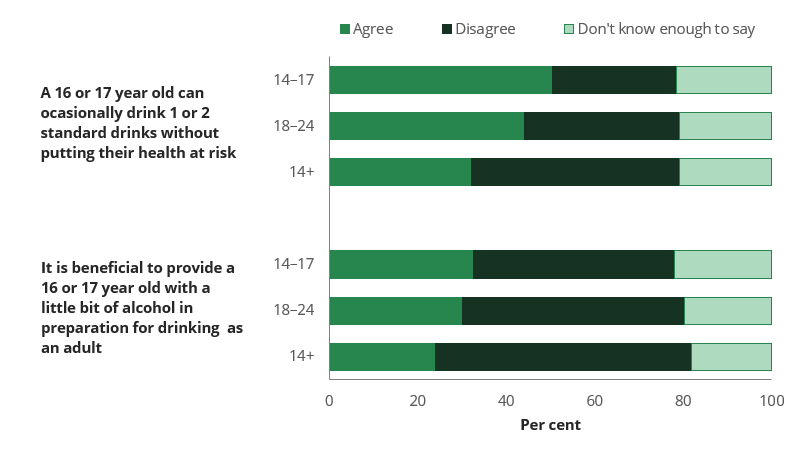
Source: NDSHS 2022–2023, Table 4.44.
These statements are in contradiction to the Australian alcohol guidelines, which recommend that children and young people under the age of eighteen should not drink alcohol. When asked about whether they were aware that Australia has guidelines that provide advice on how to reduce their health risks from drinking alcohol, people aged 14–17 were the least likely to say that they were aware (51%), followed by people aged 18–24 (58%).
These findings indicate that young people were less likely than other people in Australia to be aware of the health risks associated with consuming alcohol under the age of eighteen.
Young people’s awareness about alcohol consumption during pregnancy
In contrast to the underage drinking advice, young people generally had a good understanding of alcohol advice for people who were pregnant or planning a pregnancy. For those aged 18–24:
- Almost all (91%) agreed that pregnant women should not drink any alcohol during pregnancy.
- Only 8.2% believed that occasionally drinking a small amount of alcohol while pregnant would not harm the baby, much less than the general population (12.7%).
- A large majority (85%) agreed that, for women who are breastfeeding, not drinking alcohol is safest for their baby. This was the same level as the general population.
For people aged 14–17, results were similar: 9 in 10 (88%) agreed that pregnant women should not drink any alcohol during pregnancy, and 10.1% thought it would not cause harm to the baby to occasionally consume 1 standard drink. They were less likely to agree that women who are breastfeeding should not drink alcohol as the safest option for their baby (80%), as a result of more people reporting they did not know enough to say (14.7% compared with 8.2% of people aged 14 and over).


